Plasma Glutamine as a Prognostic Biomarker in Localized Prostate Cancer: Comparison of Conventional Variables in Risk Stratification
This study investigated the biomarker potential of glutamine among known prognostic variables in localized prostate cancer.
Abstract
Background: Glutamine uptake has been shown to contribute to local prostate cancer growth and therapeutic resistance. We investigated the biomarker potential of glutamine among known prognostic variables in localized prostate cancer.
Methods: Plasma glutamine was measured by bioluminescence assay (Promega) in clinically annotated, pre–radical prostatectomy (RP) samples granted by the Prostate Cancer Biorepository Network. Univariate and multivariable Cox regressions of biochemical recurrence-free survival (bRFS) were performed. The performance of multivariable models was assessed with Harrell’s c-statistics with internal validation by estimating and correcting possible optimism in c-statistics using the bootstrap method with 1000 replicates.
Results: Plasma glutamine levels were measured in a total of 125 patients with localized prostate cancer prior to RP. The majority were Gleason score 7 (70%), pathologic T2c (59%), and N0 (95%). The median plasma glutamine level was 442 µmol/L (interquartile range [IQR], 387-533) and median pre-RP prostate-specific antigen (PSA) was 5.36 (IQR, 4.4-7.5). The median bRFS was 6.19 years (95% CI, 3.96-6.82) with a 5-year bRFS rate of 55% (95% CI, 46%-63%). On univariate analysis, glutamine level was not significantly associated with known prognostic variables or bRFS (HR, 0.98; 95% CI, 0.83-1.15; P = .80), although higher pre-RP PSA and Gleason score, perforated capsule, positive margins, N1 disease, higher pathologic T stage, and higher D’Amico and Cambridge Prognostic Group (CPG) risk scores were significantly associated with bRFS (all P <.05). In the absence of correlation between glutamine and bRFS, we assessed the performance of 10 multivariable models incorporating various pre-RP and post-RP clinicopathologic variables to predict for bRFS in our cohort. A model with Gleason score, pre-RP PSA, and clinical T stage carried the highest predictive accuracy (c-statistic, 0.73; 95% CI, 0.65-0.80), although the D’Amico risk score (c-index, 0.64) had a lower predictive accuracy than the CPG risk score (c-index, 0.69).
Conclusions: Pre-RP glutamine levels are not predictive of prognosis in localized prostate cancer. Risk scores such as D’Amico or CPG remain the top predictors of bRFS in our cohort. Further development of novel prognostic biomarkers—eg, genomic classifiers—is needed to better risk stratify indolent from biologically aggressive prostate cancer.
Oncology (Williston Park). 2021;35(9):528-535.
DOI: 10.46883/ONC.2021.3509.0528
Introduction
Prostate cancer represents the most commonly diagnosed malignancy and the second- leading cause of cancer-related death in US men in 2021.1 Approximately 76% of patients with prostate cancer are diagnosed with organ-confined or localized disease, while the rest present with locoregional or distant metastases.1 The management of localized prostate cancer is varied, reflecting the spectrum of disease biology: It can include slow-growing, indolent disease, whereby individuals are likely to die from competing comorbidities, and more aggressive disease, in which the probabilities of relapse following definitive treatment and progression to systemic disease are high.2
To assist in clinical decision-making for the management of localized prostate cancer, many groups, including the Cambridge Prognostic Group (CPG), have created classification systems that generate composite scores of clinical stage, Gleason score, and prostate-specific antigen (PSA) level that seek to risk-stratify patients; the D’Amico risk classification system, in particular, has been incorporated into the National Comprehensive Cancer Network and American Urological Association guidelines.3-5 In patients categorized as low risk, for example, active surveillance is preferred, while radical prostatectomy (RP) or androgen-deprivation therapy (ADT) with radiation therapy is preferred in those with intermediate- or high-risk disease.6 However, despite the widespread use of such prognostic scores in prostate cancer management, these risk classifications are not failproof in their ability to distinguish aggressive from indolent disease. Accordingly, efforts are ongoing to identify predictors of aggressive or indolent disease that can improve guidance for routine clinical decision-making in prostate cancer.
Glutamine is a conditionally essential amino acid in cancer cells, and it can serve as a source of energy to meet the high metabolic requirements of these cells that are important for tumor growth.7 Taylor et al were among the first investigators to demonstrate that elevated levels of glutamate, which is converted from glutamine by the amidohydrolase enzyme glutaminase, were found in tumor tissues of 12 patients with localized prostate cancer, compared with patients with benign prostatic hyperplasia.8 In a separate cohort of patients with newly diagnosed, untreated, clinically localized prostate cancer, serum glutamate levels were significantly and positively associated with Gleason score and prostate cancer aggressiveness (the latter defined using Gleason score, clinical stage, and PSA at diagnosis), when compared with normal subjects.9
In this retrospective study, we aimed to evaluate the potential of glutamine as a prognostic biomarker in blood samples collected from patients with clinically localized prostate cancer. Specifically, we explored associations between glutamine levels with conventionally known clinicopathologic variables of prognostic significance in prostate cancer. We lastly analyzed the association of glutamine and these prognostic variables to biochemical recurrence-free survival (bRFS).
Methods
Patients and samples
Plasma samples from 125 patients with clinically localized prostate cancer were granted by the Prostate Cancer Biorepository Network (PCBN). All blood samples were collected at the time of RP (ie, the same day as surgery but prior to RP). These plasma samples were derived using a standard centrifugation protocol from blood in lavender ethylenediaminetetraacetic acid (EDTA) tubes collected prior to radical prostatectomy from 2002 to present. Briefly, blood in EDTA tubes were centrifuged at 1300 to 1800 g for 10 to 15 minutes using a designated centrifuge (IEC/Centra or accuSpin) and the resultant supernatant (plasma) was dispensed into 1.8-ml plastic cryovials in 0.1 to 1.0 mL aliquots, depending on the PCBN site. All tubes were then stored at –80 °C and clinically annotated. This study was deemed by our institution’s institutional review board to be exempt from full review, given that all biospecimens dispersed are anonymized and deidentified and retrieved from a publicly available biorepository by the PCBN. The process of obtaining informed consents from patients for procurement and storage of biospecimens and
demographic, clinical, pathological, and/or epidemiological data by the PCBN has been described.10
Glutamine measurements
Glutamine was measured in blood plasma using the Glutamate/Glutamine-Glo Assay (Promega) following manufacturer protocol.11 Plasma samples were assayed for glutamine in triplicate. A deproteinization step was performed in plasma samples prior to glutamine detection. The absorbance was measured at 450 nm using a Bio-Rad Benchmark plus microplate spectrophotometer (Bio-Rad Laboratories).
Statistical analyses
The primary objectives of this analysis were to associate plasma glutamine levels and clinicopathologic factors, to associate glutamine and clinicopathologic variables to bRFS, and to compare multivariable models as predictors of bRFS. Data are presented as frequency (%) for categorical variables and mean (± SD) and median (interquartile range [IQR]) for continuous variables. The D’Amico risk classification is stratified into low, intermediate, and high risk, while the CPG risk classification is stratified from lowest risk (score of 1) to highest risk (score of 5).3-5 Univariate associations between glutamine level and clinicopathologic factors were examined with Wilcoxon rank-sum test, Kruskal-Wallis test, or Spearman rank correlation, as appropriate. Survival functions were estimated by the Kaplan-Meier method.12 Univariate and multivariable analyses of bRFS were performed using a Cox proportional hazards model.13 bRFS was defined as the time from surgery to biochemical recurrence.14 Patients who did not recur were considered censored at the date of last follow-up. The proportional hazards assumption was assessed with scaled Schoenfeld residuals.15 Multivariable analysis with clinicopathologic factors was performed using a stepwise variable selection procedure based on Akaike Information Criterion.16 Possibility of multicollinearity was assessed by tolerance and the variance inflation factor. The performance of the multivariable models was assessed with Harrell’s c-statistics.17 Internal validation was performed by estimating and correcting possible optimism in c-statistics using the bootstrap method with 1000 replicates.18 Analyses were performed using R version 4.0.3 with 2-sided tests and a significance level at P <.05.19
Results
Patient characteristics
Pre-RP plasma samples from a total of 125 patients with untreated, localized prostate cancer were included (Table 1). The median age of the cohort was 59 years (IQR, 56-64) with a median pre-RP PSA of 5.36 ng/mL (IQR, 4.4-7.5). The majority of patients had Gleason scores of 6 (27%) and 7 (70%), clinical T1 (52%) and T2 (47%) disease, no capsule perforation (76%), negative margins from RP (69%), pathologic N0 stage (95%), intermediate-risk disease by D’Amico (58%), and CPG score of 2 (42%). The mean and median plasma glutamine levels of the cohort were 486 µmol/L and 442 µmol/L, respectively.
TABLE 1. Patient Characteristics
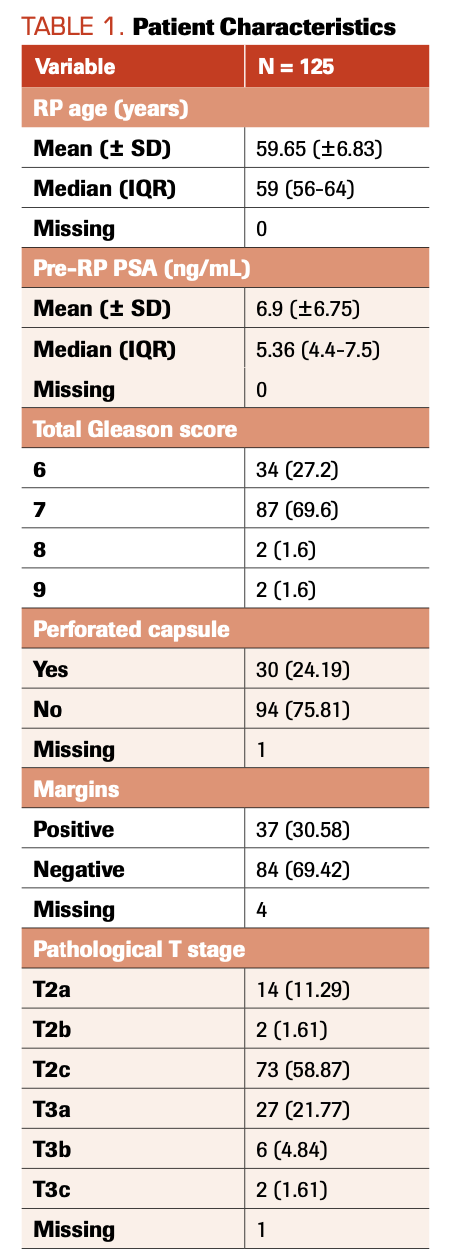
TABLE 1. Patient Characteristics (continued)
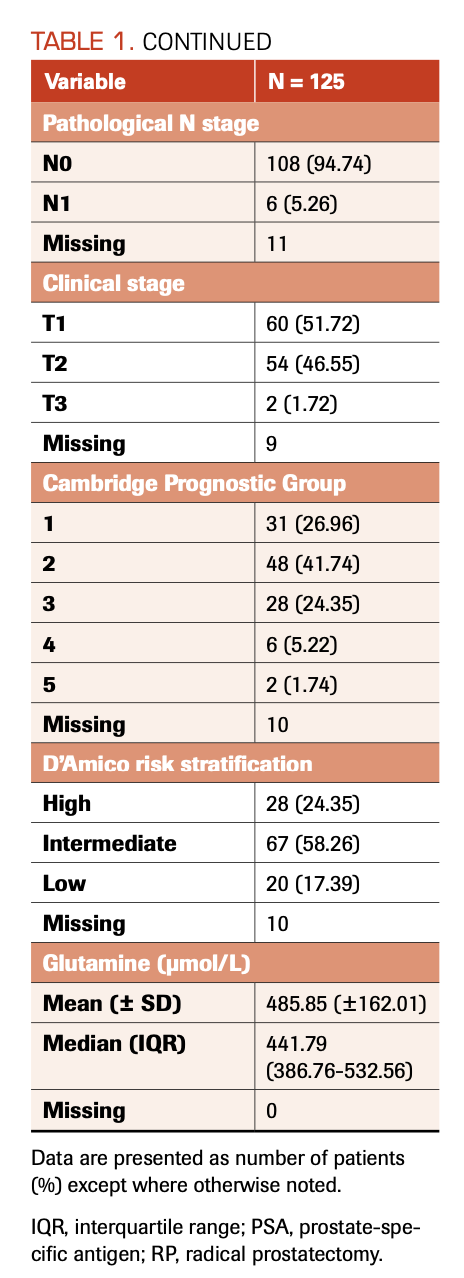
Correlative analyses of glutamine, clinicopathologic variables, and bRFS
On univariate analyses of plasma glutamine and clinicopathologic variables including age, pre-RP PSA, Gleason score, perforated capsule status, margin status, clinical and pathologic T stage, pathologic N stage, CPG score, and D’Amico risk stratification, glutamine level in this cohort was not significantly associated with these variables, suggesting that pre-RP plasma glutamine is independent of known clinicopathologic prognostic indicators in localized prostate cancer (Table 2).
On univariate analyses of bRFS, pre-RP plasma glutamine level, age, and clinical stage were not associated with bRFS in this cohort (Table 3). However, high levels of pre-RP PSA and total Gleason score; perforated capsule; positive margins; pathologic T2b, T3a, T3b, and T3c stage compared with T2a; pathologic N1 stage; and high scores of CPG and D’Amico risk stratification were significantly associated with bRFS (all P <.05).
TABLE 2. Univariate Associations Between Glutamine and Other Variables
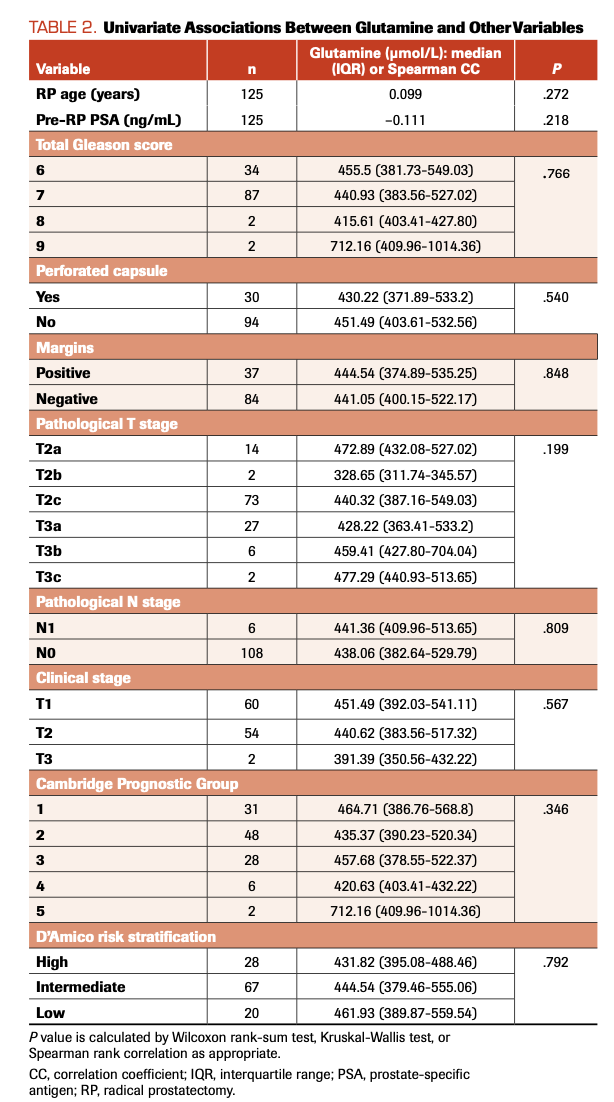
TABLE 3. Univariate Analyses of Biochemical Recurrence-Free Survival
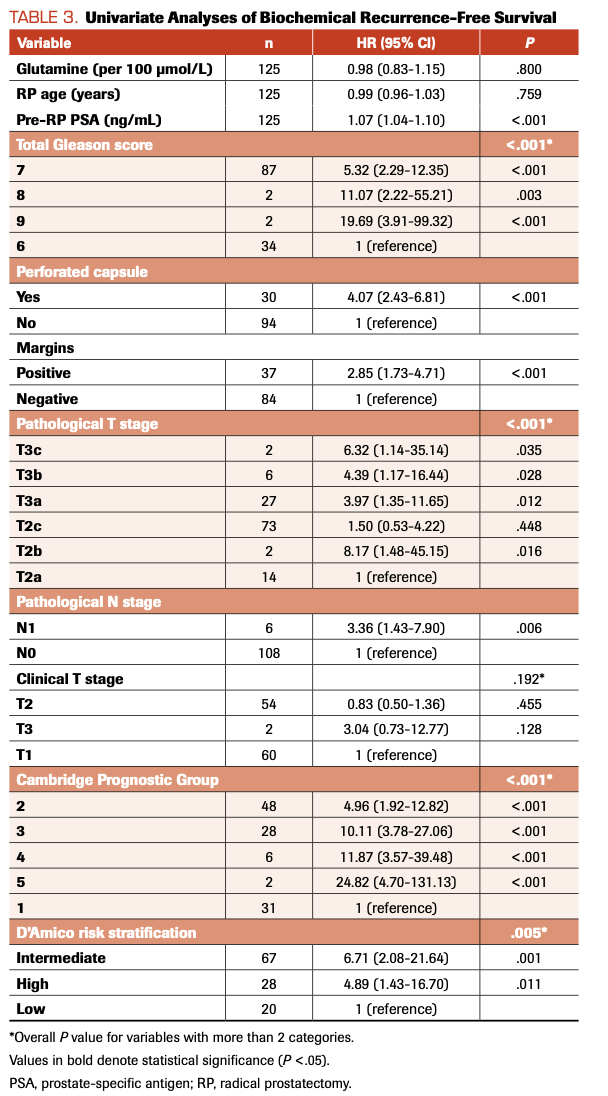
Multivariable models as predictors of bRFS
The median bRFS in our localized prostate cancer cohort was 6.19 years (95% CI, 3.96-6.82), and the 5-year estimated bRFS rate was 55.20% (95% CI, 46.07%-63.41%) (Figure). In the absence of correlation between glutamine and bRFS, we assessed the performance of 10 multivariable models incorporating various pre-RP and post-RP clinicopathologic variables to predict for bRFS in our cohort (Table 4). Multivariable models 1 through 4 essentially contained variations of Gleason score, pre-RP PSA, and clinical T stage. Models 5 through 7 incorporated only 1 of either Gleason score, pre-RP PSA, and clinical T stage in evaluating their performance as a predictor of bRFS in this cohort. Models 8 and 9 involved the classical D’Amico and CPG risk stratifications, respectively, while model 10 incorporated post-RP features of perforated capsule and surgical margin status.
In short, the multivariable model with Gleason score, pre-RP PSA, and clinical T stage carried the highest predictive accuracy (c-statistic, 0.727; 95% CI, 0.651-0.803) than any of the models incorporating 1 or 2 of these clinicopathologic variables, the least accurate of which was the multivariable model reliant on clinical T stage only (Model 7: c-statistic, 0.541; 95% CI, 0.475-0.607). The model with Gleason score and pre-RP PSA only had the second highest predictive accuracy for bRFS (c-statistic, 0.708; 95% CI, 0.634-0.782). Notably, the D’Amico risk stratification (c-index, 0.636; 95% CI, 0.567-0.705) had a lower predictive accuracy than the CPG risk score (c-index, 0.698; 95% CI, 0.626-0.769).
FIGURE. Kaplan-Meier Estimates of Biochemical Recurrence-Free Survival (bRFS)
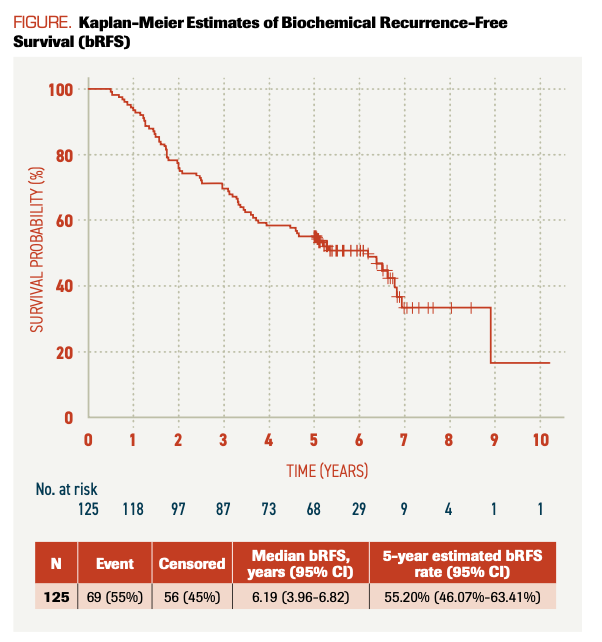
TABLE 4. Comparison of Models Predicting Biochemical Recurrence-Free Survival

TABLE 4. Comparison of Models Predicting Biochemical Recurrence-Free Survival (continued)

Discussion
In this retrospective analysis of a cohort of 125 patients with localized, untreated prostate cancer from the PCBN, we evaluated pre-RP blood samples for glutamine to determine its potential as a biomarker in this setting. The rationale behind this study was based on growing evidence that glutamine is an essential fuel source that supports the high energy demands of prostate cancer to promote tumor proliferation and therapy resistance.20,21 Furthermore, in preclinical models, inhibiting glutamine metabolism has shown the ability to sensitize prostate cancer to radiation therapy and hormonal therapy.20-22 In human patients with prostate cancer, an initial study by Koochekpour and colleagues demonstrated that when compared with levels in normal human subjects, serum glutamate levels were significantly increased in men with primary prostate cancer but returned to normal in men with metastatic castration-resistant prostate cancer (mCRPC).9 Among primary prostate cancer cases, serum glutamate levels were significantly associated with Gleason score and African-American race, while there were significant differences in glutamate levels across low-, intermediate-, and high-risk localized disease.
In contrast with the results of Koochekpour et al, we did not find any association in our localized prostate cancer cohort between pre-RP plasma glutamine levels and various clinicopathologic prognostic indicators, including Gleason score, CPG score, and D’Amico risk stratification. Pre-RP plasma glutamine was not significantly associated with bRFS, either. Our data therefore support that glutamine is not a prognostic biomarker in localized, untreated prostate cancer. A potential biologic explanation for this finding has been provided by preclinical evidence suggesting that treatment with ADT increases glutamine concentration.21 More advanced and therapy-resistant prostate cancer cells become increasingly addicted to glutamine as the disease progresses, which may be driven by an isoform switch of the enzyme glutaminase 1 in prostate cancer cells that have been subjected to androgen deprivation. Our group has separately shown that the regulation of glutamine metabolism to support further prostate cancer progression may be mediated by an androgen deprivation–induced epigenetic alteration in tumor-supporting prostate stromal fibroblasts, rather than the prostate cancer epithelial cells themselves.22 Regardless of the potential mechanism, ADT appears to be critical for glutamine production to support continued prostate cancer growth.
Along these lines, it should be mentioned that our cohort of patients had samples collected pre-RP, at a point when none of these subjects had been exposed to ADT for localized prostate cancer. In separate retrospective cohorts of mCRPC patients treated with either local ablative radiation therapy20 or taxanes,23 higher levels of plasma glutamine were significantly correlated with shorter PSA doubling time and worse PSA progression-free survival, defined as time to first PSA progression, respectively. It may be possible that plasma glutamine was a predictive biomarker in these populations due to treatment with ADT and/or androgen receptor (AR) signaling inhibitors in these patients with advanced-stage, castrate-resistant prostate cancer. Our findings are therefore consistent with the hypothesis that plasma glutamine loses its biomarker potential in patients with prostate cancer who have not been exposed to hormone therapy. We are actively and prospectively accruing advanced prostate cancer patients treated with ADT in an adequately powered evaluation of the potential for plasma glutamine levels to serve as prognostic and predictive biomarkers in this population.
Future considerations in evaluating the biomarker potential of glutamine in advanced prostate cancer include the temporal and intrapatient variance of glutamine levels, particularly due to AR signaling modulation with hormonal therapies. Although tumor assessments of glutamine would be ideal, availability of tumor specimens in the metastatic setting is often limited when the bone is the most common site of metastatic disease. Primary RP specimens may often represent an earlier disease stage, with different biology and lower exposure to ADT, rather than advanced stages of disease. In this regard, sampling at the same time of the day and under fasted conditions may be better served for plasma glutamine measurements, while serial sampling may allow for assessments of change in glutamine levels in those on hormonal therapy (over time) with each patient serving as their own internal control. Lastly, although ADT is involved in the regulation of glutamine metabolism, future studies are needed to evaluate the impact of glutamine on AR signaling to further understand this relationship as a potential mechanism of therapeutic resistance and prostate cancer progression.
Our analysis of the multivariable models we generated indicated that the model incorporating Gleason score, pre-RP PSA, and clinical T stage remained the best predictor of bRFS in this cohort. Interestingly, the D’Amico risk stratification had a lower predictive accuracy than the CPG risk score. This result is consistent with those of other studies, as the CPG classification integrates recommendations of the International Society of Urological Pathology on the grading of prostate cancer and it has been shown in head-to-head comparisons to perform better than the D’Amico risk classification in discriminating prostate cancer death in the nonmetastatic setting.24,25 Our multivariable model incorporating post-RP factors such as margin status and capsule perforation also fared better than the D’Amico risk classification in predicting bRFS (Table 4). Our findings support that postsurgical factors should be considered in the development of newer models seeking to predict recurrence risk. However, these predictive models would not be as helpful as current models that help guide discussions for surveillance vs RP vs ADT + RT—ie, in the pretreatment planning phase of localized prostate cancer management. The CAPRA-S score is among the prognostic models designed recently to predict for prostate cancer recurrence and mortality through inclusion of post-RP variables.26
In the future, tissue-based molecular testing or genomic classifiers utilizing multigene expression classification (GEC) may represent a more optimized and personalized strategy for clinical decision-making in patients with newly diagnosed localized prostate cancer. Researchers using GEC tests such as Decipher, Oncotype DX Prostate, and Prolaris have begun investigation into large, observational cohorts of patients with localized prostate cancer in whom changes in management have occurred because of the use of GEC tests, particularly patients with favorable-risk disease. However, other research groups have shown that GEC tests did not significantly improve stratification of risk over standard clinical variables alone in men with low-risk prostate cancer.27,28 For now, the D’Amico risk score remains at the core of the most widely recognized risk classifications used by national guidelines set forth by the American Urological Association, American Society for Radiation Oncology, and Society of Urologic Oncology, and by the National Comprehensive Cancer Network.6,29
Conclusions
Glutamine has been shown to serve as an energy source that supports prostate cancer proliferation. We therefore evaluated the biomarker potential of plasma glutamine in blood samples collected prior to RP in patients with untreated, localized prostate cancer. In this setting, pre-RP plasma glutamine did not associate with various clinicopathologic factors of known prognostic significance and bRFS. However, glutamine production is intricately related to ADT exposure, and evaluation of its biomarker potential is likely better suited for the advanced prostate cancer setting, in which patients have been heavily pretreated with androgen signaling inhibition. Lastly, we analyzed the performance of 10 multivariable models using different combinations of clinicopathologic variables to predict for bRFS; a model incorporating Gleason score, pre-RP PSA, and clinical T stage emerged as the best predictor of bRFS in this cohort. Development of novel markers such genomic classifiers may improve upon the performance of existing risk classifications in prostate cancer, or independently guide our endeavors to better distinguish indolent from aggressive disease.
Financial Disclosure: EP has consulting or advisory roles with CytoLumina, Genentech/Roche, Janssen Oncology, Janssen, and Novartis; serves on Speakers’ Bureau for Bayer; receives research funding from Pfizer; holds patents on NanoVelcro Assay for CTCs in prostate cancer; and receives travel, accommodations, and expenses from TRACON Pharma. RF serves as leadership for 4Dx, and Apollomics, Inc; has consulting or advisory role with Bristol Myers Squibb, CBT Pharmaceuticals, and Johnson & Johnson, receives research funding from Bristol Myers Squibb (Inst), Calithera Biosciences (Inst), Exelixis (Inst), Merck (Inst), Peloton Therapeutics (Inst). JG has consulting or advisory roles with EMD Serono, Elsevier, Exelixis, QED Therapeutics, Natera, Basilea, HalioDx, Eisai, and Janssen Pharmaceuticals, Inc.
Funding source: This work is supported by the Department of Defense Prostate Cancer Research Program, Award No W81XWH-18-2-0013, W81XWH-18-2-0015, W81XWH-18-2-0016, W81XWH-18-2-0017, W81XWH-18-2-0018 and W81XWH-18-2-0019 Prostate Cancer Biorepository Network (PCBN).
References
1. Siegel RL, Miller KD, Fuchs HE, Jemal A. Cancer statistics, 2021. CA Cancer J Clin. 2021;71(1):7-33. doi:10.3322/caac.21654
2. Rebello RJ, Oing C, Knudsen KE, et al. Prostate cancer. Nat Rev Dis Primers. 2021;7(1):9. doi:10.1038/s41572-020-00243-0
3. D’Amico AV, Whittington R, Malkowicz SB, et al. Biochemical outcome after radical prostatectomy, external beam radiation therapy, or interstitial radiation therapy for clinically localized prostate cancer. JAMA. 1998;280(11):969-974. doi:10.1001/jama.280.11.969
4. Gnanapragasam VJ, Bratt O, Muir K, et al. The Cambridge Prognostic Groups for improved prediction of disease mortality at diagnosis in primary non-metastatic prostate cancer: a validation study. BMC Med. 2018;16(1):31. doi:10.1186/s12916-018-1019-5
5. Gnanapragasam VJ, Lophatananon A, Wright KA, Muir KR, Gavin A, Greenberg DC. Improving clinical risk stratification at diagnosis in primary prostate cancer: a prognostic modelling study. PLoS Med. 2016;13(8):e1002063. doi:10.1371/journal.pmed.1002063
6. Sanda MG, Cadeddu JA, Kirkby E, et al. Clinically localized prostate cancer: AUA/ASTRO/SUO guideline. part I: risk stratification, shared decision making, and care options. J Urol. 2018;199(3):683-690. doi:10.1016/j.juro.2017.11.095
7. Wise DR, Thompson CB. Glutamine addiction: a new therapeutic target in cancer. Trends Biochem Sci. 2010;35(8):427-433. doi:10.1016/j.tibs.2010.05.003
8. Taylor BS, Pal M, Yu J, et al. Humoral response profiling reveals pathways to prostate cancer progression. Mol Cell Proteomics. 2008;7(3):600-611. doi:10.1074/mcp.M700263-MCP200
9. Koochekpour S, Majumdar S, Azabdaftari G, et al. Serum glutamate levels correlate with Gleason score and glutamate blockade decreases proliferation, migration, and invasion and induces apoptosis in prostate cancer cells. Clin Cancer Res. 2012;18(21):5888-5901. doi:10.1158/1078-0432.CCR-12-1308
10. Prostate Cancer Biorepository Network. Standard Operating Procedure, SOP No. 001, Obtaining Informed Consent. Accessed August 20, 2021. https://bit.ly/3j4q9NU
11. Promega corporation. Glutamine/Glutamate-Glo Assay, Instructions for Use of Products. Accessed August 20, 2021. https://bit.ly/3geswvR
12. Kalbfleisch JD, Prentice RL. The Statistical Analysis of Failure Time Data. Wiley Series in Probability and Mathematical Statistics. John Wiley & Sons; 1980.
13. Cox DR. Regression models and life tables. J Royal Stat Society. 1972;B34(2):187-220.
14. Scher HI, Morris MJ, Stadler WM, et al; Prostate Cancer Clinical Trials Working Group 3. Trial design and objectives for castration-resistant prostate cancer: updated recommendations from the Prostate Cancer Clinical Trials Working Group 3. J Clin Oncol. 2016;34(12):1402-1418. doi:10.1200/JCO.2015.64.2702
15. Grambsch PM, Therneau TM. Proportional hazards tests and diagnostics based on weighted residuals. Biometrika. 1994;81(3):515-526. doi:10.1093/biomet/81.3.515
16. Yamashita T, Yamashita K, Kamimura R. A stepwise AIC method for variable selection in linear regression. Communications In Statistics - Theory And Methods. 2007;36(13):2395-2403. doi:10.1080/03610920701215639
17. Harrell FE. Regression Modeling Strategies: With Applications to Linear Models, Logistic Regression, and Survival Analysis. 2nd ed. Springer; 2001.
18. Harrell FE Jr, Lee KL, Mark DB. Multivariable prognostic models: issues in developing models, evaluating assumptions and adequacy, and measuring and reducing errors. Stat Med. 1996;15:361-387. doi:10.1002/(SICI)1097-0258(19960229)15:4<361::AID-SIM168>3.0.CO;2-4
19. R Core Team. R: A language and environment for statistical computing. R Foundation for Statistical Computing. Vienna, Austria. 2020.
20. Mukha A, Kahya U, Linge A, et al. GLS-driven glutamine catabolism contributes to prostate cancer radiosensitivity by regulating the redox state, stemness and ATG5-mediated autophagy. Theranostics. 2021;11(16):7844-7868. doi:10.7150/thno.58655
21. Xu L, Yin Y, Li Y, et al. A glutaminase isoform switch drives therapeutic resistance and disease progression of prostate cancer. Proc Natl Acad Sci U S A. 2021;118(13):e2012748118. doi:10.1073/pnas.2012748118
22. Mishra R, Haldar S, Placencio V, et al. Stromal epigenetic alterations drive metabolic and neuroendocrine prostate cancer reprogramming. J Clin Invest. 2018;128(10):4472-4484. doi:10.1172/JCI99397
23. Pereira Diaz V, Marin M, Jiménez N, et al. Association of high plasma glutamine levels with outcome in metastatic castration-resistant prostate (mCRPC) patients treated with taxanes. J Clin Oncol. 2020;38(suppl 6):abstr 164. doi:10.1200/JCO.2020.38.6_suppl.164
24. Parry MG, Cowling TE, Sujenthiran A, et al. Risk stratification for prostate cancer management: value of the Cambridge Prognostic Group classification for assessing treatment allocation. BMC Med. 2020;18(1):114. doi:10.1186/s12916-020-01588-9
25. Zelic R, Garmo H, Zugna D, et al. Predicting prostate cancer death with different pretreatment risk stratification tools: a head-to-head comparison in a nationwide cohort study. Eur Urol. 2020;77(2):180-188. doi:10.1016/j.eururo.2019.09.027
26. Punnen S, Freedland SJ, Presti JC Jr, et al. Multi-institutional validation of the CAPRA-S score to predict disease recurrence and mortality after radical prostatectomy. Eur Urol. 2014;65(6):1171-1177. doi:10.1016/j.eururo.2013.03.058.
27. Hu JC, Tosoian JJ, Qi J, et al. Clinical utility of gene expression classifiers in men with newly diagnosed prostate cancer. JCO Precis Oncol. 2018;2:PO.18.00163. doi:10.1200/po.18.00163
28. Lin DW, Zheng Y, McKenney JK, Brown MD, Lu R, Crager M, et al. 17-gene genomic prostate score test results in the Canary Prostate Active Surveillance Study (PASS) cohort. J Clin Oncol. 2020;38(14):1549-1557. doi:10.1200/JCO.19.02267
29. NCCN. Clinical Practice Guidelines in Oncology. Prostate cancer, version 2.2021. Accessed July 20, 2021. https://bit.ly/3iZ5Npk
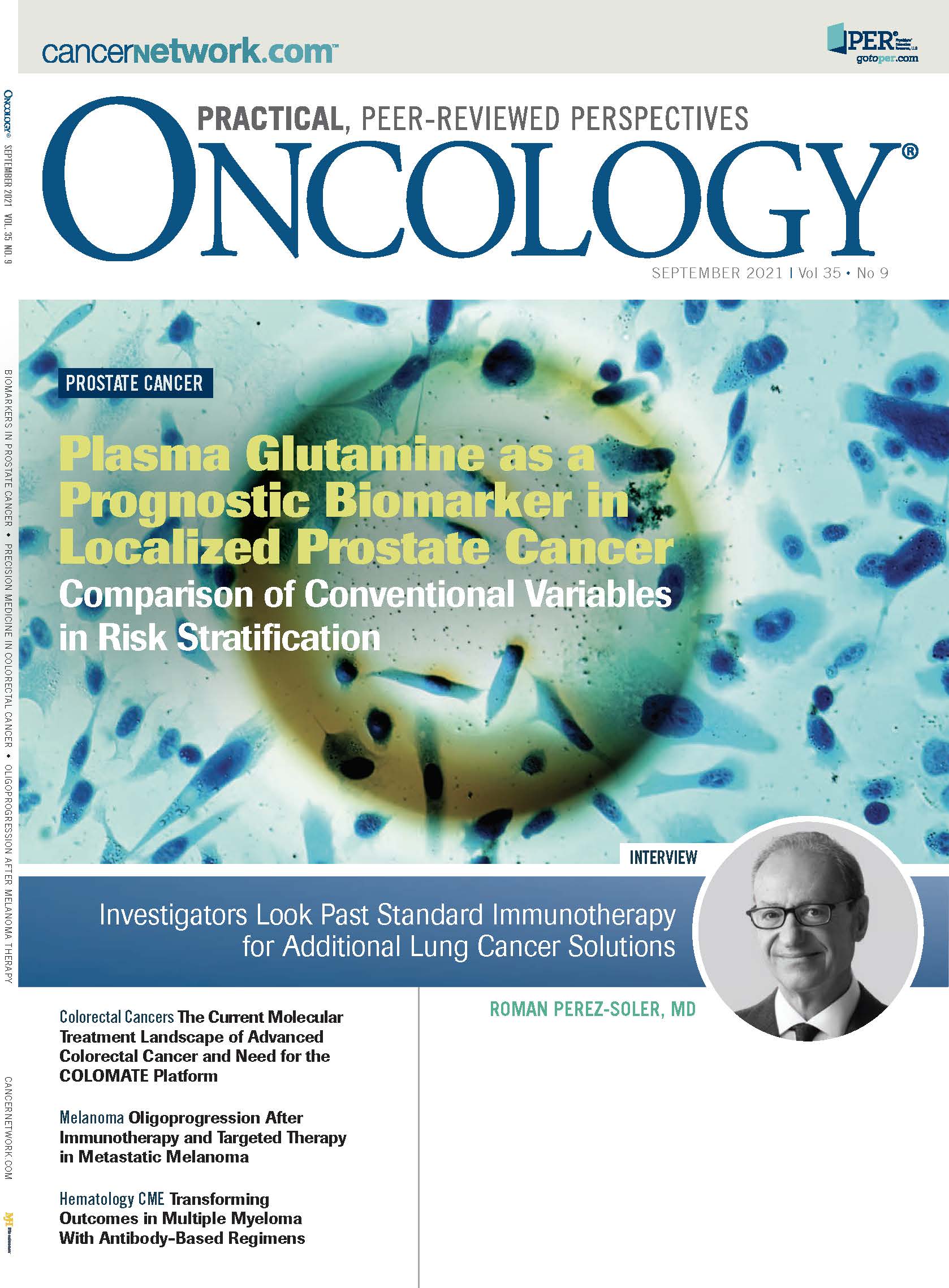
Newsletter
Stay up to date on recent advances in the multidisciplinary approach to cancer.
Navigating Treatment Intensification in Metastatic Hormone-Sensitive Prostate Cancer
A patient case of a 50-year-old man with hormone-sensitive prostate cancer sparked a debate among oncologists regarding the best course of action.